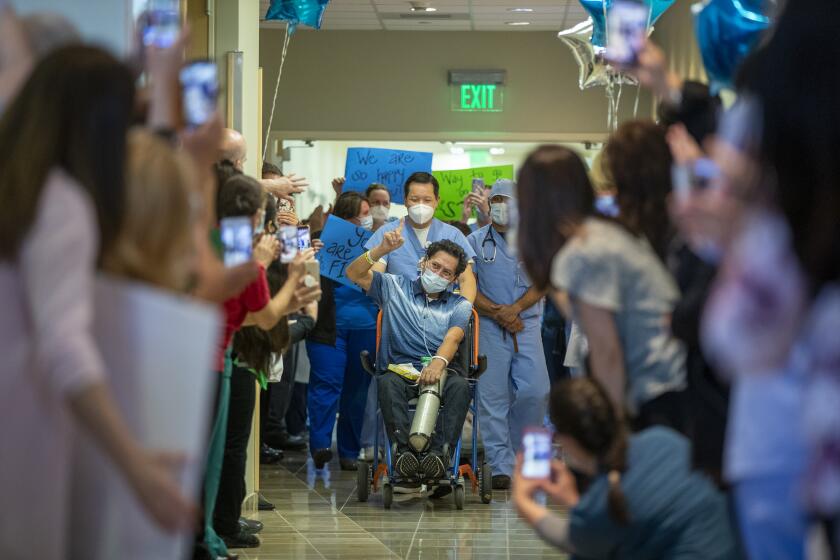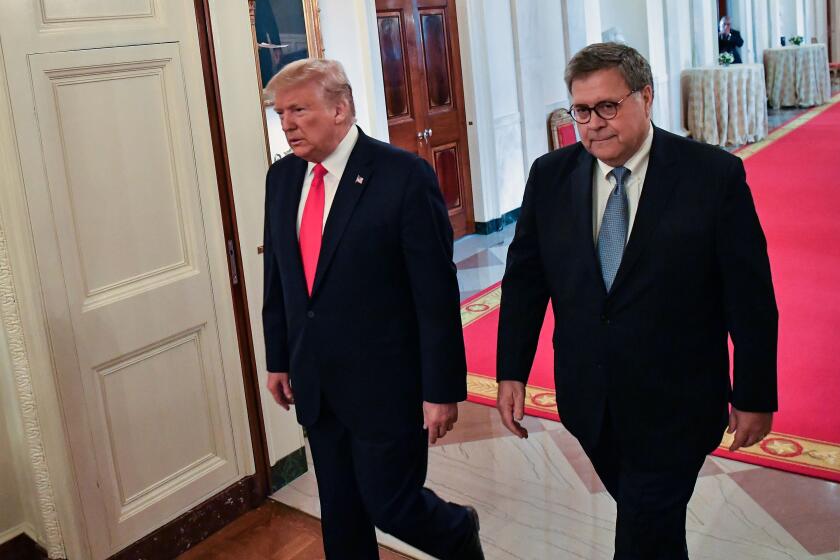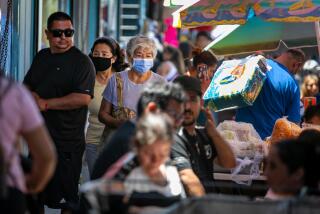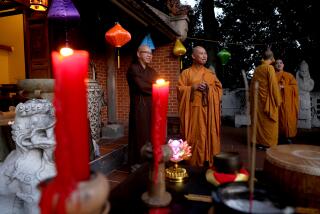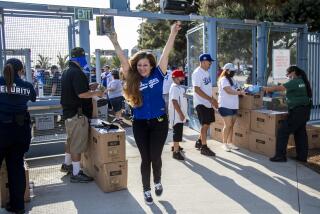Battling lockdown fatigue, California messages both hope and fear. Will it work?

- Share via
When the Spanish flu erupted in Los Angeles in the fall of 1918, health officers had few means of warning the city’s half-million residents.
With a wartime ban on civilian radios in place, officials relied on newspapers, posters and crowded public meetings to urge Angelenos to keep their kids out of school, skip church and stay home.
Now, as the world battles an entirely new pandemic, city and county officials have vastly more ways to communicate with a population of roughly 10 million. Television, radio, electronic billboards, email, social media and cell phone alerts are all being used to deliver the official line on social distancing, business closures and home sheltering.
These are some of the unusual new scenes across the Southland during the coronavirus outbreak.
But this fractured media landscape may prove to be a messaging nightmare as California enters its second month of lockdown. While officials say the public’s adherence to health messaging has shown quantifiable results in “flattening the curve” of new COVID-19 cases, they caution that we are nowhere near the end of this emergency and that we cannot become complacent.
Some residents are losing patience, however. Already, small groups of protesters complaining of lockdown fatigue have demanded an end to restrictive health measures, while Ventura and Riverside counties have announced plans to ease stay-at-home restrictions. To confuse matters further, President Trump has called on some states to “liberate” themselves from coronavirus lockdowns.
“As of right now there’s a very small but vocal minority,” said Los Angeles Emergency Management Department spokeswoman Kate Hutton. “The vast majority of our people are at home ... and we thank them profusely for it because it’s saving lives.”
The pandemic’s toll: Lives lost in California
Hundreds of people have died in California due to the COVID-19 pandemic. These are some of their stories.
In years past, both the county and city have struggled to effectively communicate with the public during emergencies.
During the Woolsey fire in 2018, Los Angeles County relied too heavily on social media, and left many older residents in the dark about the approaching fire. A year later, a computer coding error prevented city staff from using emergency notification software to warn people of the Saddle Ridge fire.
Now, facing a much slower-moving disaster, officials are working to keep the public listening. They must balance grim news of deaths and infections with seeds of hope, but not over-promise results.
“People have a tendency to tune out especially if you instill fear without a solution. Then why listen?” said Wändi Bruine de Bruin, provost professor of public policy, psychology and behavioral science at USC. “But if you start people with too much optimism then people expect big outcomes quickly. And if those outcomes don’t happen, then they feel that their efforts were a waste and why continue to do this?”
Working together in a joint information center, emergency management officials from the city and county have so far struck the right tone about the threat and what Angelenos can do to stay safe without sowing irrational fear into the community, experts say.
In March, the county hired two communication firms at a cost of $400,000 and reorganized its emergency management plan so that what the public hears is consistent across departments. It also created a digital billboard campaign and COVID-19 website and hosted weekly briefings with media organizations serving minority communities, said Helen Chavez, the county’s Joint Information Center spokeswoman.
The city, meanwhile, has sent out a dozen messages to more than a million email addresses, cell phones and landlines with quarantine and mask-wearing guidance and rules about essential travel and where to get tested. On March 27, the city sent an Amber Alert-style message to all cellphones in the county, and virtually every day, Mayor Eric Garcetti and county health officials host daily press conferences broadcast live on TV and social media.
“You need to communicate with people using what they use. … It takes a multimedia approach to reach people,” said Craig Fugate, who served as a top emergency manager for Florida Gov. Jeb Bush and then as the administrator of the Federal Emergency Management Agency under President Obama. “And a consistent messaging from local communities’ leaders.”
By the time fire season arrives, officials hope the spread of COVID-19 will taper off, but preparations are already being made.
When that message is undermined by a dissenting voice within the group, it ripples down into the public’s psyche, experts say.
“There is a huge impact in terms of how people interpret these messages,” said Jose Rodriguez, a professor of communications studies at California State University Long Beach. “Notice that in Florida, there [was] an incoherent, inconsistent message. When you get a mixed signal, people then do one of two things: They think that is not important, or they go into confusion, which is understandable human behavior.”
Empathy also helps a message resonate, Rodriguez said, like when California Surgeon Gen. Dr. Nadine Burke Harris at a press conference squashed a pernicious rumor that the coronavirus did not infect black people and followed that up by encouraging Californians to maintain human connections, even if it’s just online.
“People are starving for connection, attention, relationships. It’s just confirming what people are already feeling in their bodies,” Rodriguez said. “And in that way, it’s a huge statement of collective empathy. We’re all feeling alone, afraid, and now our state government has said, ‘We hear you.’”
Los Angeles and the state as a whole have had some success in slowing the virus’ spread, officials say. Though the number of new cases and deaths reported each day continues to increase, Gov. Gavin Newsom said social distancing has been successful in helping to flatten the curve here.
About 95% of the county’s residents supported the existing stay-at-home order as of early April, according to a Loyola Marymount poll.
But since that poll, the rhetoric from the federal government and surrounding communities has shown public patience is waning. Los Angeles Mayor Eric Garcetti said last week the city won’t consider amending its quarantine restrictions until at least May 15.
The Justice Department weighed in on a social distancing case in Mississippi to strike a blow for Trump’s side in the coronavirus culture wars.
But any easing of restrictions will have to be done with extreme caution, according to experts.
“We continue to make progress, and the spread of COVID-19 has leveled out, but relaxing physical distancing measures very suddenly would negate and reverse all of that progress we’ve made to date,” Los Angeles Department of Health services Director Dr. Christina Ghaly cautioned at a press conference Thursday.
Such was the city’s experience in 1918.
Los Angeles was one of the few major metropolitan cities then that wisely canceled its Liberty Day parade that year. But the city’s closures also weren’t as strict as today’s or as long-lasting, said Alex Navarro, assistant director of the University of Michigan’s Center for the History of Medicine.
After local officials thought they’d endured the worst of the outbreak, they relaxed the rules.
“I can’t speak to whether going out in public was more or less popular then, but I can say that we read numerous stories across many American cities where there was a flood of people who went out as soon as the social orders were removed, lines around the block for theaters,” Navarro said. “It led to another spike of cases ... that was deadlier than the first.”
More to Read
Sign up for Essential California
The most important California stories and recommendations in your inbox every morning.
You may occasionally receive promotional content from the Los Angeles Times.

